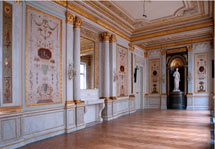
Handy Links
SLAC News Center
SLAC Today
- Subscribe
- Archives: Feb 2006-May 20, 2011
- Archives: May 23, 2011 and later
- Submit Feedback or Story Ideas
- About SLAC Today
SLAC News
Lab News
- Interactions
- Lightsources.org
- ILC NewsLine
- Int'l Science Grid This Week
- Fermilab Today
- Berkeley Lab News
- @brookhaven TODAY
- DOE Pulse
- CERN Courier
- DESY inForm
- US / LHC
SLAC Links
- Emergency
- Safety
- Policy Repository
- Site Entry Form

- Site Maps
- M & O Review
- Computing Status & Calendar
- SLAC Colloquium
- SLACspeak
- SLACspace
- SLAC Logo
- Café Menu
- Flea Market
- Web E-mail
- Marguerite Shuttle
- Discount Commuter Passes
-
Award Reporting Form
- SPIRES
- SciDoc
- Activity Groups
- Library
Stanford
Around the Bay
BaBar Funding Committee's Final Meeting Celebrates International Collaboration
The BaBar International Finance Committee, a group that considers the financial needs of the BaBar collaboration, met for the final time last Tuesday. The meeting took place in Paris and covered recent progress on the experiment and the final years of BaBar funding.
"BaBar was founded as a truly international collaboration and the IFC, embodying a sense of shared ownership by the international funding agencies, is an essential part of the laboratory's approach to the B Factory experiment," said SLAC Director of Particle Physics and Astrophysics David MacFarlane. "Over the years the IFC has been very creative and instrumental in resolving the many challenges faced by BaBar."
The IFC was first formed in 1995 by David Leith, then SLAC's director of research, in collaboration with founding BaBar Spokesman David Hitlin and under the direction of then-SLAC Director Burton Richter. The committee is an external body managed by SLAC and comprises representatives from the major funding agencies that contributed to the construction and operation of BaBar. For a decade and a half, the committee met semiannually to review progress on the experiment and to approve allocation of funds to defray ongoing expenses.
"The committee was absolutely crucial to the success of building and operating BaBar," said Leith. "The members were fully engaged in making this first big internationally funded science experiment in the U.S. a success, and they delivered in a remarkable way."
The IFC typically met twice a year. In more recent years, one of these meetings took place at SLAC and one in a country that collaborates on the BaBar experiment. This week's meeting, which took place at the U.S. Embassy's George C. Marshall Center in Paris, was attended by 19 representatives from Canada, France, Germany, Italy, Spain, BaBar, SLAC and the Department of Energy.
"The hospitality and warm welcome of Frederic Maerkle, the U.S. scientific counselor in Paris, and Madame Elizabeth Larouer, curator of the Marshall Center, have transformed the BaBar IFC meeting into an unforgettable experience," said Gerard Bonneaud, who organized both the IFC meeting and a celebration that followed. "We also noted the interesting fact that our final finance committee [meeting] took place in the building dedicated to George C. Marshall, who established the Marshall plan, which contributed so much to the success of the European Recovery Program after the Second World War."
Jonathan Dorfan, in an address sent to the event's organizers, commented, "The blending of researchers from 12 countries has produced a rich cultural and technical exchange, and countless friendships that will last a lifetime have been made. Each collaborating community is the richer for the BaBar experience."
The evening celebration following the IFC meeting took place at the Cercle de l'Union Interalliée, a social and dining club established in 1917. Attendees included the IFC members, BaBar collaborators, representatives of diplomatic missions in Paris of countries that collaborate on BaBar, the presidents of French-American societies, and representatives of the Centre National de la Recherche Scientifique, Centre d'Etudes Nucléaires de Saclay, the Organization for Economic Cooperation and Development, CERN, and the Ministere de l'Enseignement Superieur et de la Recherche. The celebration concluded with remarks by CERN Director General Rolf Heuer about the future of international science collaboration.
"BaBar has been and remains a beautiful project," said BaBar Spokesman Francois Le Diberder. "We have published more than 420 papers in the best journals in the world, and we have had more than 360 students earn their PhDs working on the experiment. BaBar is a striking example of a very, very successful international science collaboration, and a big part of that success is thanks to the steady support of the IFC."
—Kelent Tuttle
SLAC Today, July 22, 2010
